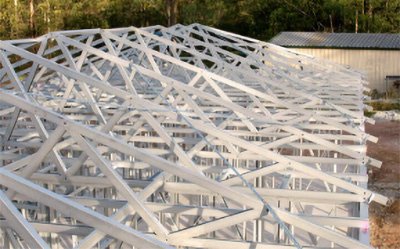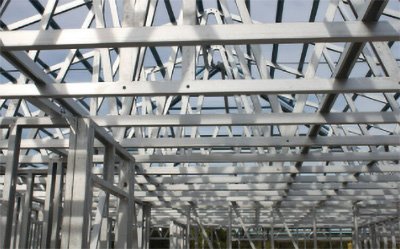The role of Light Gauge Steel Framing in modern construction
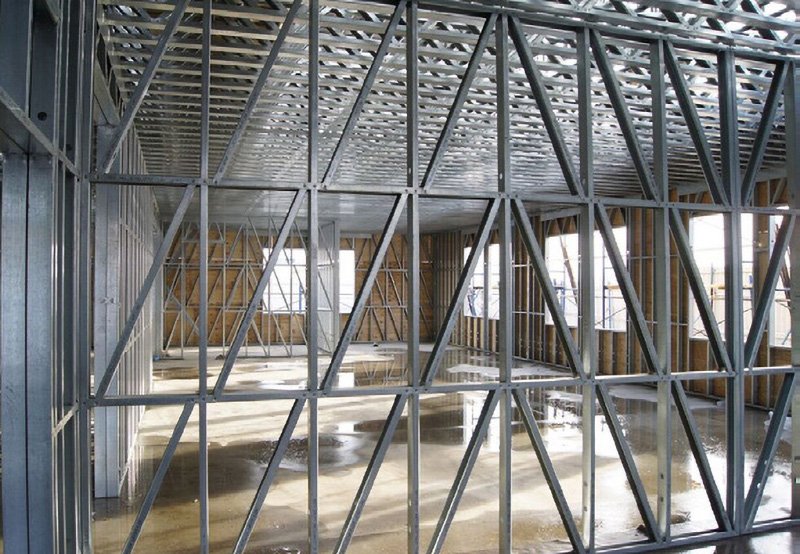
Explore why Light Gauge Steel Framing has gained traction as the material of choice for modern construction
Light Gauge Steel Framing (LGS) has seen rapid adoption by the construction industry with its compelling performance characteristics combined with the speed and efficiency of construction it offers.
Used in projects ranging from residential homes to large-scale industrial buildings, LGS is setting new standards for modern construction delivering better buildings, built smarter.
Unlike timber for framing, LGS framing components are manufactured using roll-forming technology offsite and delivered in one of three ways:
-
pre-formed as studs and tracks in standard lengths to be cut and connected onsite (similar to timber framing construction and often referred to as ‘stick-built’);
-
framing automation using precision formed LGS framing components printed in a set order for delivery in packs - effectively a ‘kit-of-parts’ – lightweight, easily moved and quickly assembled onsite;
-
fully panelised framing that is manufactured in the factory and put together on the factory floor and delivered ready to install – saving 14x the time and labour in a side-by-side experiment versus stick built systems.
"As an industry, construction has massive potential to leverage technology to improve efficiency throughout the construction cycle, and to build better buildings as a result. Light gauge steel is proving itself to be the ideal base material to contribute to that,” says Nick Coubray, CEO of Howick.
This comprehensive overview explores the performance characteristics, applications and benefits of light gauge steel framing, showcasing its increasing role in shaping the future of construction.
No time? Here’s the snackable takeaway on LGS framing:
Faster, more efficient builds
Light gauge metal framing is manufactured with precise roll-forming technology, which drastically speeds up onsite assembly, saving time and labour to improve profitability.
Greater strength and durability
LGS framing offers better structural integrity than wood or concrete of similar weight, resisting fire, pests, warping, and harsh weather events - all while remaining surprisingly lightweight.
Sustainability on multiple fronts
Steel framing reduces waste by up to 10 times compared to timber. Plus, a high percentage of LGS can be recycled, making it a more eco-friendly option.
Design flexibility and accuracy
Computer-aided design (CAD) and roll-forming technology allow for precise, custom components from light gauge metal. This level of accuracy means fewer errors, less rework, and the freedom to tackle more complex or creative architectural projects.
Table of Contents
What is Light Gauge Steel for framing?
Light Gauge Steel is also known as cold-formed steel framing. Manufactured from thin gauge, high tensile steel, the term "light gauge" refers to the thinness of the steel sheets used. It typically ranges between 0.75mm and 2.5 mmin thickness (approx. 1/32 and 3/32 of an inch), with sheets trimmed to manageable widths and rolled up onto coils for storage.
This ‘coiled steel’ is then shaped using roll-forming machines like Howick’s FRAMATM range, to create framing components such as studs, tracks, and joists.
The roll-forming process happens at room temperature, allowing for increased precision and consistency (unlike LGS’s heavy duty cousin - hot rolled steel used for load bearing requirements, which requires high temperatures and welding to prepare it).
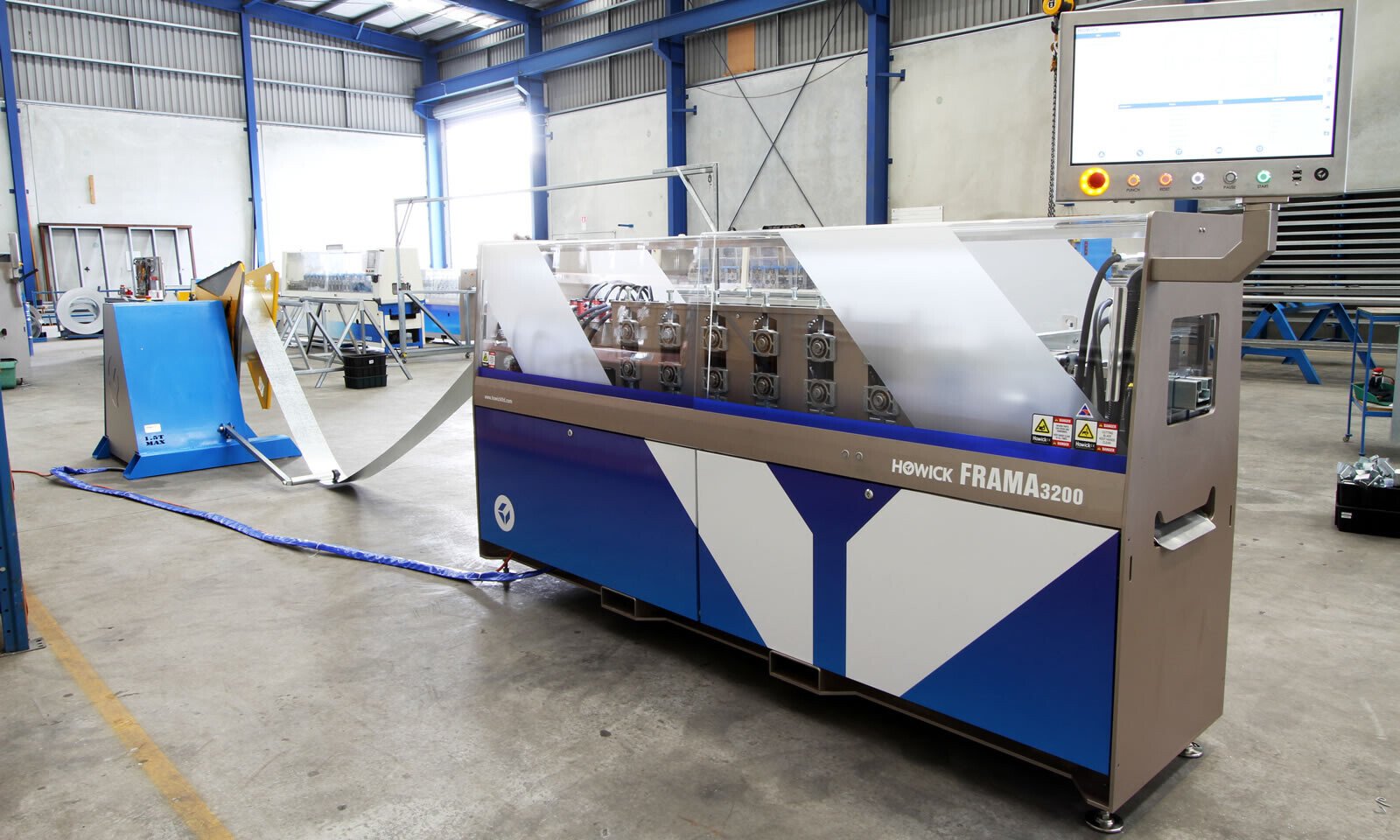
Light Gauge Steel framing thickness and performance differences
The thickness of LGS framing determines its strength, durability and suitability for specific applications:
-
0.5 mm (approx. 26 gauge) to 1.0 mm (approx. 20 gauge):
• Commonly used for interior non-load-bearing walls and partitions
• Lightweight and easy to handle, making it ideal for quick installations
-
1.0 mm (approx. 20 gauge) to 1.5 mm (approx. 16 gauge):
• Suitable for some load-bearing requirements in residential and small-scale commercial construction
• Offers a balance of strength and flexibility, while still being light in weight
-
1.5 mm (approx. 16 gauge) to 2.5 mm (approx. 12 gauge):
• Designed for heavy-duty applications such as mid-rise multi-storey buildings and industrial projects
• Provides higher structural integrity and with Howick technology, it can be formed with load-bearing capacity
Light Gauge Steel framing as an alternative to timber or brick
Light Gauge Steel framing is an advanced construction method that offers a modern alternative to traditional timber framing and brick-built techniques.
If you are familiar with timber framing, think of it as swapping standard 4x2” wooden studs for light gauge steel framing sections that are lighter, stronger, and pre-fabricated to be incredibly precise.
Always straight and true, light gauge steel framing components such as studs, tracks, and joists fit together seamlessly – a bit like Lego or Meccano, forming the structural skeleton of a building.
Unlike timber, steel doesn't warp, rot, or attract pests. It is fire-resistant and does not combust, making it ideal for high-risk locations.
Additionally, the precision used to manufacture LGS means fewer onsite errors and faster assembly, especially when paired with offsite prefabrication technology.
Offsite manufacturing with Howick's systems, for example, has been proven to reduce construction timelines significantly, as components are delivered ready for onsite assembly. This efficiency shines through in projects like this modular housing development in the Denmark, where 100 apartments were completed significantly faster than using traditional methods.
For those used to working with brick, LGS offers an efficient framework that complements brickwork beautifully. It serves as a strong and lightweight alternative for internal walls, facades, or even full building frameworks.
Its recyclability and waste reduction capabilities further set it apart, contributing to more sustainable construction practices. And at the end of a building’s life, LGS demonstrates exceptional recyclability. Globally, around 85% is recycled, with up to 93% of light structural steel currently recycled in the UK.
Indeed, LGS in construction has an average of just 2% wastage, compared to up to 20% for timber1
Light Yet Mighty: Steel’s Strength-to-Weight Surpasses Wood and Concrete: This article discusses how CFS's superior strength-to-weight ratio leads to more efficient construction, reduced material costs, and enhanced sustainability.
Whether you're retrofitting a historic stone church or constructing a new modular build, LGS is a game-changing material for modern construction.
The advantages of Light Gauge Steel framing
More details are in our article on 10 reasons to build with light steel, but here’s why LGS framing is stealing an advantage over traditional construction methods:
Light Gauge Steel framing goes up faster
When one of New Zealand’s top home builders made the transition to roll-formed, light gauge steel framing, the results were astonishing. With just four staff, they were able to complete one 2000 square foot (180 square metre) house per day!
In another example, this time from the UK, a 9-storey block was completed in just 16 weeks with LGS – well ahead of its 30-week schedule.
Light Gauge Steel framing is more accurate
Light gauge steel framing is accurate to within 1/64th of an inch or 0.5mm when manufactured with a Howick FRAMATM rollforming machine. That means lower building costs, less rework, less downtime and fewer penalties.
And because all punching and fixing holes are placed with computer-aided precision, steel frames, trusses and floor cassettes are all self-locating and jigging, again contributing to significant time savings.
Light Gauge Steel framing Is 21x more efficient
In the construction of a simple, two-story house, 1 cubic metre of timber was shown to produce 0.124 houses. With the same volume of steel, 3.3 houses were built - 21 times more!
And in a side-swipe for the waste industry, there’s typically 10x less wastage with steel than timber.
Light Gauge Steel framing is 30% lighter than timber
LGS framing is approximately one-third of the weight of its timber equivalent. It creates a lighter, stronger structure compared to both timber and concrete, resulting in higher earthquake and wind load strengths.
Its lightweight nature makes light gauge steel framing easier to handle, reducing transportation costs and fuel consumption. And your crew will love you for it!
Light Gauge Steel framing is fire resistant and robust
With the ability to withstand temperatures of up to 1000 degrees Celsius, it is highly fire resistant, a critical advantage in fire-prone regions. And it probably won’t blow away or fall over... its combination of strength and flex means light gauge steel framing-built buildings are capable of withstanding 240 kilometre per hour winds, and an earthquake of up to 9 on the Richter Scale.
Furthermore, LGS resists pests, rot, and warping, making it a durable solution that requires minimal maintenance over its lifespan, even in the toughest of conditions.
Light Gauge Steel framing is recyclable
LGS framing is made with 25% recycled steel and stands out as one of the most sustainable building materials. With light steel, 85% is currently recycled at the end of its lifecycle. And up to 93% of light structural steel is currently recycled in the UK. What’s more, it can continue to be recycled infinitely with no degradation.
Light Gauge Steel framing improves design flexibility
LGS framing can be manipulated to support complex architectural designs offering unmatched precision, enabling builders and architects to push creative boundaries.
Howick’s technology seamlessly integrates with BIM and the latest in 3D construction design software, making it ideal for innovative and aesthetically ambitious projects.
Check out how the latest work in computational design and prefab are opening up creative construction.
Light Gauge Steel framing applications
Our roll-forming machines and technology continue to drive a rapid evolution in the applications for light gauge steel framing in construction. The extensive range of applications Howick’s customers are currently exploiting include:
-
Frames and trusses
-
Lattice floor joists
-
Modular construction
-
Volumetric models
-
Bathroom pods
-
Sheds, including wide span sheds
-
Extendable infill and retrofit interior framing
-
Complex curving building facades and installations
-
Portal frame buildings
-
Mezzanine floors
-
Staircases
-
Roofing systems
-
Disaster zone emergency housing, hospitals and clinics
-
Solar panels
-
Hybrid construction
Case studies: Light Gauge Steel framing in action
Victoria Lane Apartments in New Zealand
Rising above the vibrant Cuba Quarter in Wellington, New Zealand, the Victoria Lane Apartments is a first for many reasons.
Not only is it the first base-isolated residential development in Wellington, but it is also one of the first major projects in New Zealand to incorporate telescopic light gauge steel panels which are adjustable and expandable to fit interior spaces easily and quickly.
Manufactured by Rollforming Services using the Howick X-TENDA™ 3600, these telescopic panels are a ground-breaking solution that cut installation time by 50%, compared with traditional timber framing. They also dramatically reduced waste and associated labour costs.
Broadmeadows, Melbourne project, by Steel Frames Direct
With Australia’s chronic timber shortage continuing to bite, Melbourne-based Steel Frames Direct helped construction clients stay on top of project demands with a superior light gauge steel framing solution.
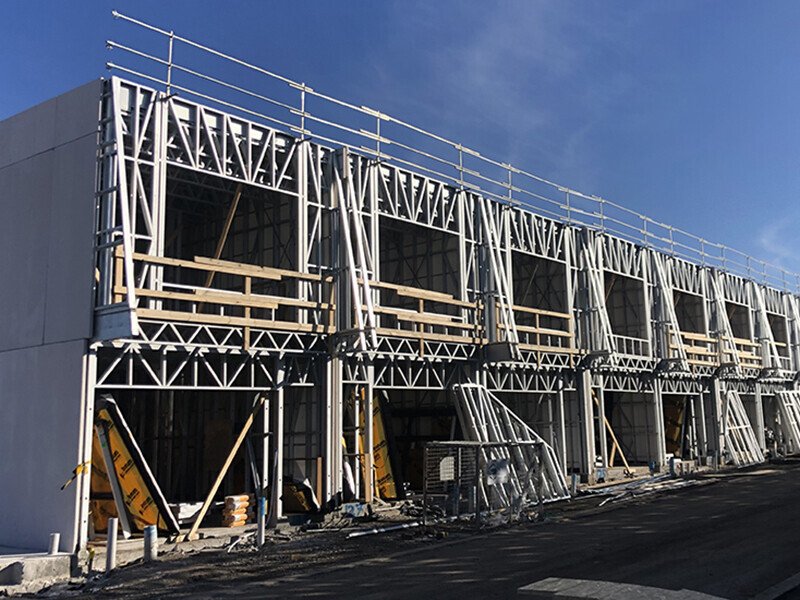
Steel Frames Direct was able to offer a reliable supply chain (compared with their traditional timber framing supplier competitors), plus a faster, more accurate solution that produces less waste onsite. Delivering all the LGS framing to the site for each project stage on schedule, Rendition Homes then framed the houses in just one to two days, thanks to the accuracy and simplicity of LGS framing.
As a bonus, this approach reduced onsite waste to produce a more environmentally friendly outcome.
The Portal: A complex fabrication collaboration in rapid time
Positioned at the heart of a new medical clinic in Playa Vista, California, The Portal is a sculptural geometric gateway. With architectural design themes influenced by the local Silicone Beach giants, such as Google, IMAX, Facebook, Electronic Arts, and many more; as well as a nod to the aeronautical manufacturing history of the area, the task called for a complex design solution.
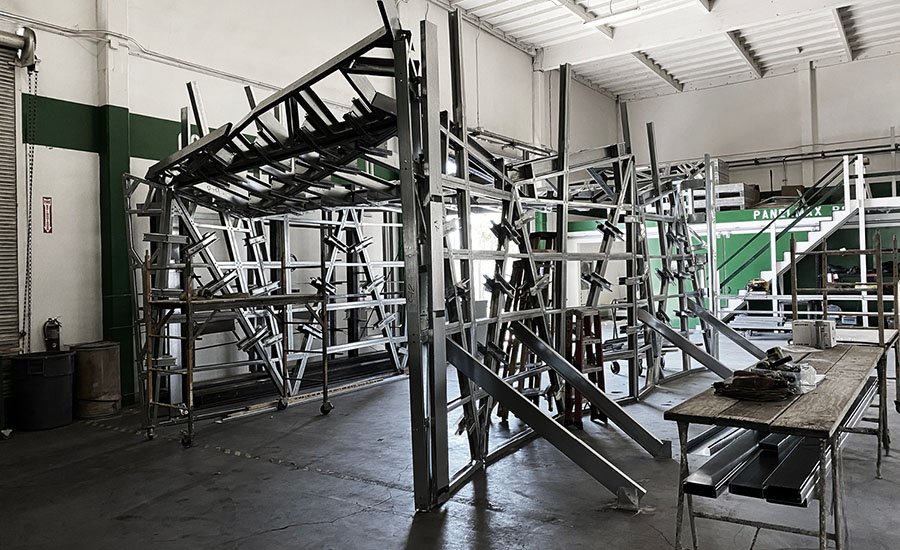
Light gauge steel framing, manufactured using Howick’s advanced roll-forming technology and STUD-IO’s computational design expertise ensured success.
FAQs about Light Gauge Steel framing
-
What makes LGS framing better than traditional materials?
LGS framing is lighter, stronger, and more durable than materials like wood and concrete. Using accurate computational design and roll-forming technology to create components, it is more efficient and faster to construct, reducing build times. Plus it resists fire, pests, and rot, making it a long-lasting and low-maintenance option.
-
Is Light Gauge Steel framing cost-effective?
Yes. The savings from faster build times, reduced labour requirements and lower waste make it a highly cost-effective choice.
-
How does LGS perform in harsh climates?
LGS excels in difficult conditions, including areas prone to extreme weather or natural disasters, due to its strength and resilience. It also resists pests and rot, making it a long-lasting and low-maintenance option in the most challenging of locations.
Building the future with Light Gauge Steel framing
Light gauge steel framing offers many benefits over timber and concrete. Combined with computer-aided design software and advanced roll-forming technology, it is redefining the way construction projects come together with its unique blend of speed, strength, precision, and sustainability.
"At Howick, we’re not just advancing technology; we like to think we’re helping build the future of construction," says Nick.
Get in touch today to learn more about Howick’s innovative solutions and talk to us about how we can transform your construction outcomes with light gauge steel framing technology.
Pass this knowledge along - share this article today.
March 2025 #Features
